Investigation and Estimation of Groundwater Level Fluctuation Potential: A Case Study in the Pei-Kang River Basin and Chou-Shui River Basin of the Taiwan Mountainous Region
Abstract
Featured Application
Abstract
1. Introduction
2. Study Area
3. Methodology
3.1. Selected Influencing Factors
3.1.1. Slope
3.1.2. Drainage Density
3.1.3. Land Use
3.1.4. Lithology
3.1.5. Hydraulic Conductivity
3.1.6. Porosity
3.1.7. Depth to the Water Table
3.1.8. Regolith Thickness
3.2. Designs of Feature Scores of Individual Influencing Factor Layers
3.3. Determination of the Weightings of Individual Influencing Factors from Groundwater Level Fluctuation Data
4. Results and Discussion
4.1. Weighting Coefficients of Influencing Factors in the Wet/Dry Season for Different Hydrological Years
4.2. Comparision of Observed and Simulated GWLF Potential
4.3. Spatial Distribution of GWLF Potential
4.4. Relationship between Rainfall and Groundwater Level Changes
5. Conclusions
- This study analyzed the groundwater level data from 18 monitoring stations for eight hydrological years. In the dry season, the groundwater level changed from 0.45 m to 6.35 m. In the wet season, the groundwater level changed from 1.30 m to 18.67 m. In addition, the spatial variations in the groundwater levels may not be consistent from year to year. This exception is presumed to be related to the lateral recharge behavior in the mountain area. However, this point should be carefully inspected by comparing the lateral flow data.
- The eight proposed environmental influencing factors, including slope, drainage density, land use, lithology, hydraulic conductivity, porosity, groundwater depth, and regolith thickness, affect GWLF potential. The contribution of each factor to GWLF potential is adjusted according to the amount of rainfall (or groundwater recharge), which is a rather complex mechanism. Although the types of data collected so far do not fully reveal this mechanism, the main controlling factors affecting groundwater level fluctuations in wet and dry seasons can be roughly obtained. In the wet season, the factors that significantly influence GWLF include K, GW, LT, D, and RT. In the dry season, the factors that significantly influence GWLF include LT, S, and P. Thus, the dominant controlling factors are not precisely the same between the wet and dry seasons.
- To verify the accuracy of the estimated GWLF results, the simulated results were compared with the observed GWLF from 18 groundwater monitoring wells with eight years of data. Overall, the verification results from 144 measurements demonstrate that the developed model can be expected to predict the GWLF for different seasons with a “good” level of accuracy, based on Donigian’s [32] guidelines of error for calibration/verification tolerances to watershed model users. Therefore, the developed model can predict the spatial GWLF distribution based on the groundwater level data from a few wells. However, it should be noted that the proposed model needs to collect more data and other types of data (e.g., lateral discharge measurements) to improve its prediction ability.
- By comparing the spatial distribution of rainfall with the GWLF data, the groundwater level changes with the seasonal rainfall for most of the wells, which can lead to the inference that the groundwater circulation is pronounced. However, the groundwater level will soon return to its normal groundwater level while rainfall stops. This implies that the aquifer cannot store groundwater easily in the mountainous area of Taiwan. In addition, the time required for the groundwater level to return to the pre-rainfall level may take a few minutes to several days. The difference may be due to the rainwater infiltrating into the saturated aquifer, which can be affected by the geomorphological, geological, and hydrogeological characteristics.
- The core of the proposed method is to obtain the weighting coefficients of the influencing factors affecting the GWLF potential by using the in situ hydrogeological test data and groundwater level data. Compared to the previous methods of using only static hydrogeological data and constant weights, the newly developed method further strengthens the input of the dynamic behavior of groundwater into the estimation of groundwater level fluctuation potential. It shows that the estimation results will have the characteristics of dynamic changes with different rainfall conditions.
Author Contributions
Funding
Institutional Review Board Statement
Informed Consent Statement
Data Availability Statement
Acknowledgments
Conflicts of Interest
References
- Green, T.R. Linking Climate Change and Groundwater. In Integrated Groundwater Management; Jakeman, A.J., Barreteau, O., Hunt, R.J., Rinaudo, J.D., Ross, A., Eds.; Springer: Cham, Switzerland, 2016. [Google Scholar] [CrossRef]
- Condon, L.E.; Kollet, S.; Bierkens, M.F.P.; Fogg, G.E.; Maxwell, R.M.; Hill, M.C.; Fransen, H.J.H.; Verhoef, A.; Van Loon, A.F.; Sulis, M.; et al. Global groundwater modeling and monitoring: Opportunities and challenges. Water Resour. Res. 2021, 57, e2020WR029500. [Google Scholar] [CrossRef]
- Ofterdinger, U.; MacDonald, A.M.; Comte, J.C.; Young, M.E. Groundwater in fractured bedrock environments: Managing catchment and subsurface resources—An introduction. Geol. Soc. 2019, 479, 1–9. [Google Scholar] [CrossRef]
- Hsu, S.M. Quantifying hydraulic properties of fractured rock masses along a borehole using composite geological indices: A case study in the mid- and upper-Choshuei river basin in central Taiwan. Eng. Geol. 2021, 284, 105924. [Google Scholar] [CrossRef]
- Jurgens, B.C.; Faulkner, K.; McMahon, P.B. Over a third of groundwater in USA public-supply aquifers is Anthropocene-age and susceptible to surface contamination. Commun. Earth Environ. 2022, 3, 153. [Google Scholar] [CrossRef]
- GebreEgziabher, M.; Jasechko, S.; Perrone, D. Widespread and increased drilling of wells into fossil aquifers in the USA. Nat. Commun. 2022, 13, 2129. [Google Scholar] [CrossRef] [PubMed]
- Hsu, S.M.; Ke, C.C.; Lin, Y.T.; Huang, C.C.; Wang, Y.S. Unravelling preferential flow paths and estimating groundwater potential in a fractured metamorphic aquifer in Taiwan by using borehole logs and hybrid DFN/EPM model. Environ. Earth Sci. 2019, 78, 150. [Google Scholar] [CrossRef]
- Central Geological Survey of Taiwan. Groundwater Resources Investigation Program for Mountainous Region of Central Taiwan(1/4); Ministry of Economic Affairs: Taipei, Taiwan, 2010.
- Finke, P.A.; Brus, D.J.; Bierkens, M.F.P.; Hoogland, T.; Knotters, M.; de Vries, F. Mapping groundwater dynamics using multiple sources of exhaustive high resolution data. Geoderma 2004, 123, 23–39. [Google Scholar] [CrossRef][Green Version]
- Wang, S.; Song, X.; Wang, Q.; Xiao, G.; Liu, C.; Liu, J. Shallow groundwater dynamics in North China Plain. J. Geogr. Sci. 2009, 19, 175–188. [Google Scholar] [CrossRef]
- Madrucci, V.; Taioli, F.; de Araújo, C.C. Groundwater favorability map using GIS multi criteria data analysis on crystalline terrain, Sao Paulo State, Brazil. J. Hydrol. 2008, 57, 153–173. [Google Scholar] [CrossRef]
- Ibrahim-Bathis, K.; Ahmed, S.A. Geospatial technology for delineating groundwater potential zones in Doddahalla watershed of Chitradurga district, India. Egypt. J. Remote Sens. Space Sci. 2016, 19, 223–234. [Google Scholar] [CrossRef]
- Arefin, R. Groundwater potential zone identification using an analytic hierarchy process in Dhaka City, Bangladesh. Environ. Earth Sci. 2020, 79, 268. [Google Scholar] [CrossRef]
- Anbarasu, S.; Brindha, K.; Elango, L. Multi-influencing factor method for delineation of groundwater potential zones using remote sensing and GIS techniques in the western part of Perambalur district, southern India. Earth Sci. Inform. 2020, 13, 317–332. [Google Scholar] [CrossRef]
- Jaiswal, R.K.; Mukherjee, S.; Krishnamurthy, J.; Saxena, R. Role of remote sensing and GIS techniques for generation of groundwater prospect zones towards rural development-an approach. Int. J. Remote Sens. 2003, 24, 993–1008. [Google Scholar] [CrossRef]
- Saraf, A.K.; Choudhary, P.R. Integrated remote sensing and GIS for groundwater exploration and identification of artificial recharge sites. Int. J. Remote Sens. 1998, 19, 1825–1841. [Google Scholar] [CrossRef]
- Shaban, A.; Khawlie, M.; Abdallah, C. Use of remote sensing and GIS to determine recharge potential zones: The case of Occidental Lebanon. Hydrogeol. J. 2006, 14, 433–443. [Google Scholar] [CrossRef]
- Yeh, H.F.; Lee, C.H.; Hsu, K.C.; Chang, P.H. GIS for the assessment of the groundwater recharge potential zone. Environ. Geol. 2009, 58, 185–195. [Google Scholar] [CrossRef]
- Rajaveni, S.P.; Brindha, K.; Rajesh, R.; Elango, L. Spatial and Temporal Variation of Groundwater Level and its Relation to Drainage and Intrusive Rocks in a part of Nalgonda District, Andhra Pradesh, India. J. Indian Soc. Remote Sens. 2014, 42, 765–776. [Google Scholar] [CrossRef]
- Yue, W.; Wang, T.; Franz, T.E.; Chen, X. Spatiotemporal patterns of water table fluctuations and evapotranspiration induced by riparian vegetation in a semiarid area. Water Resour. Res. 2016, 52, 1948–1960. [Google Scholar] [CrossRef]
- Dinka, M.O.; Loiskand, W.; Ndambuki, J.M. Seasonal Behavior and Spatial Fluctuations of Groundwater Levels in Long-Term Irrigated Agriculture: The Case of a Sugar Estate. Pol. J. Environ. Stud. 2013, 22, 1325–1334. [Google Scholar]
- Carlson Mazur, M.L.; Wiley, M.J.; Wilcox, D.A. Estimating evapotranspiration and groundwater flow from water-table fluctuations for a general wetland scenario. Ecohydrology 2014, 7, 378–390. [Google Scholar] [CrossRef]
- Yu, H.L.; Chu, H.J. Recharge signal identification based on groundwater level observations. Environ. Monit. Assess. 2012, 184, 5971–5982. [Google Scholar] [CrossRef] [PubMed]
- Mondal, N.C.; Singh, V.S. A new approach to delineate the groundwater recharge zone in hard rock terrain. Curr. Sci. 2004, 87, 658–662. [Google Scholar]
- Allen, D.M.; Stahl, K.; Whitfield, P.H.; Moore, R.D. Trends in groundwater levels in British Columbia. Can. Water Resour. J. Rev. Can. Des Ressour. Hydr. 2014, 39, 15–31. [Google Scholar] [CrossRef]
- Godin, G. The Analysis of Tides; University of Toronto Press: Toronto, ON, Canada, 1972; pp. 232–233. [Google Scholar]
- Shih, D.C.-F.; Lee, C.D.; Chiou, K.F.; Tsai, S.M. Spectral analysis of tidal fluctuations in ground water level. J. Amer Water Resour. Assoc. 2000, 36, 1087–1099. [Google Scholar] [CrossRef]
- Dong, D.W.; Lin, P.; Yan, Y.; Liu, J.R.; Ye, C.; Zheng, Y.X.; Wan, L.Q.; Li, W.P.; Zhou, Y.X. Optimum design of groundwater level monitoring network of Beijing Plain. Hydrogeol. Eng. Geol. 2007, 1, 10–19. [Google Scholar]
- El-Baz, F.; Himida, I. Groundwater Potential of the Sinai Peninsula, Egypt, Project Summery; AID: Cairo, Egypt, 1995. [Google Scholar]
- Steiakakis, E.; Gamvroudis, C.; Alevizos, G. Kozeny-Carman Equation and Hydraulic Conductivity of Compacted Clayey Soils. Geomaterials 2012, 2, 37–41. [Google Scholar] [CrossRef]
- Sabes, P.N. Linear Algebraic Equations. SVD, and the Pseudo-Inverse. 2001. Available online: https://www.cs.utexas.edu/~dana/MLClass/Sabes_LinearEquations.pdf (accessed on 12 October 2021).
- Donigian, A.S. Watershed model calibration and validation: The HSPF experience. Proc. Water Environ. Fed. 2002, 8, 44–73. [Google Scholar] [CrossRef]
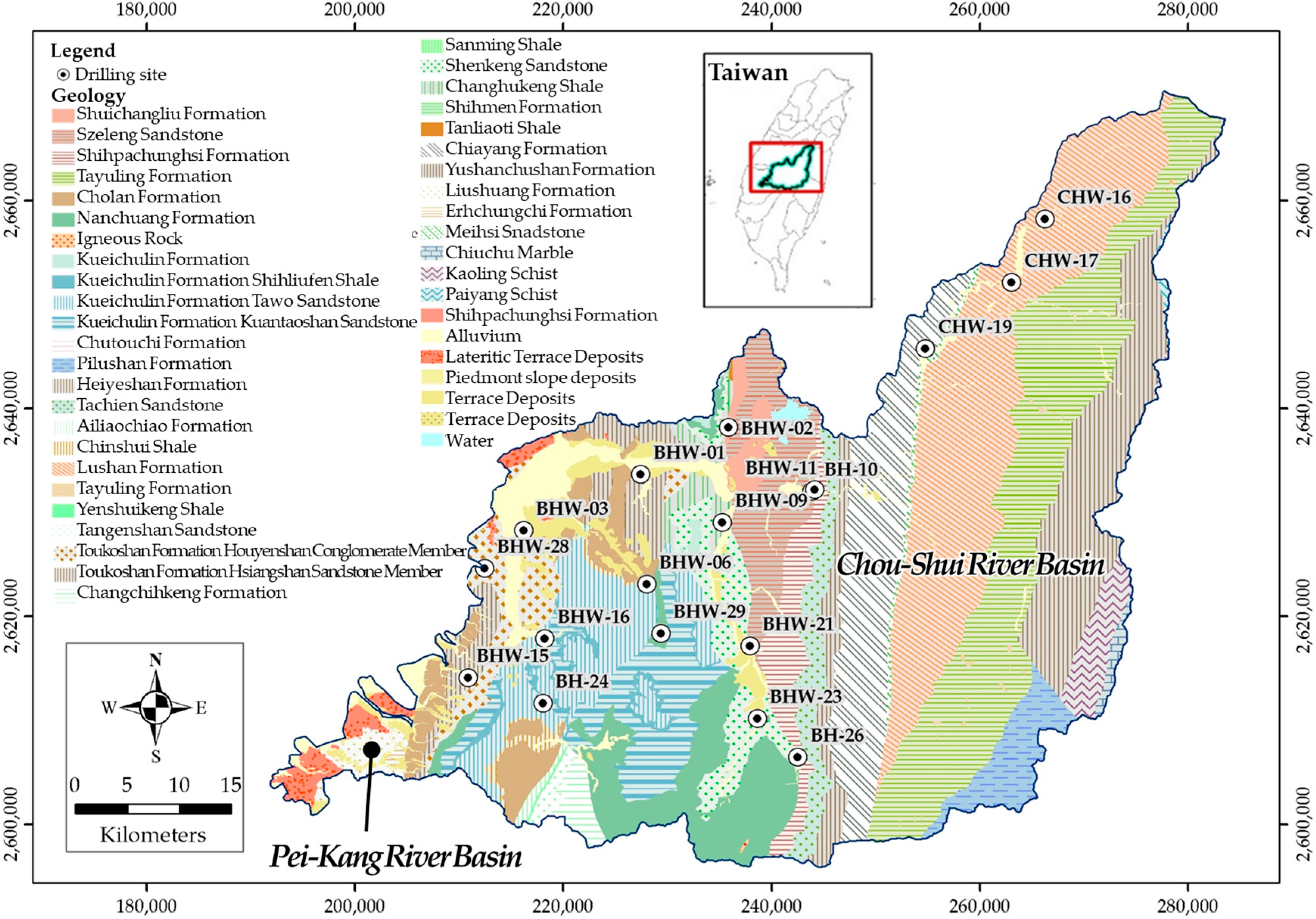
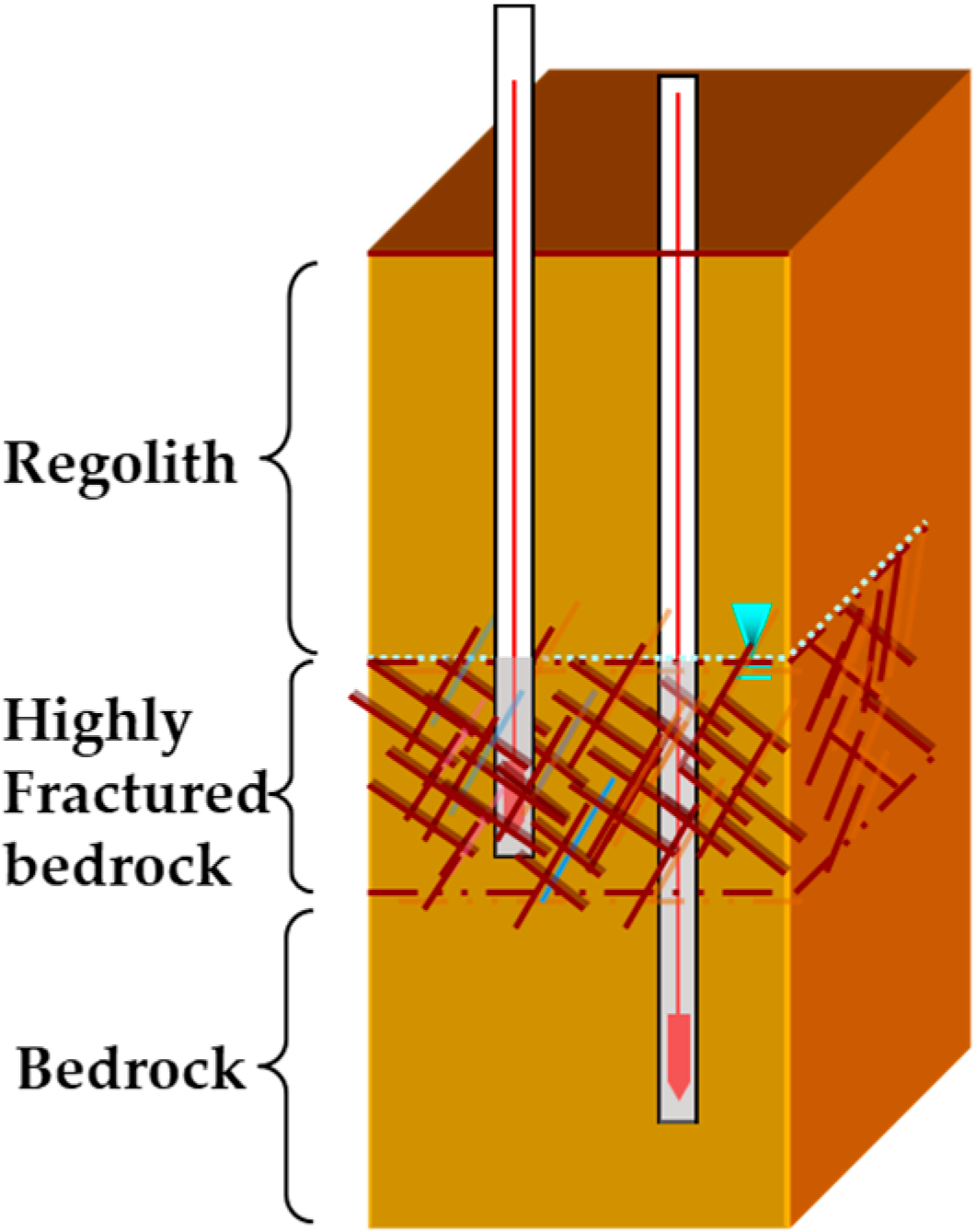
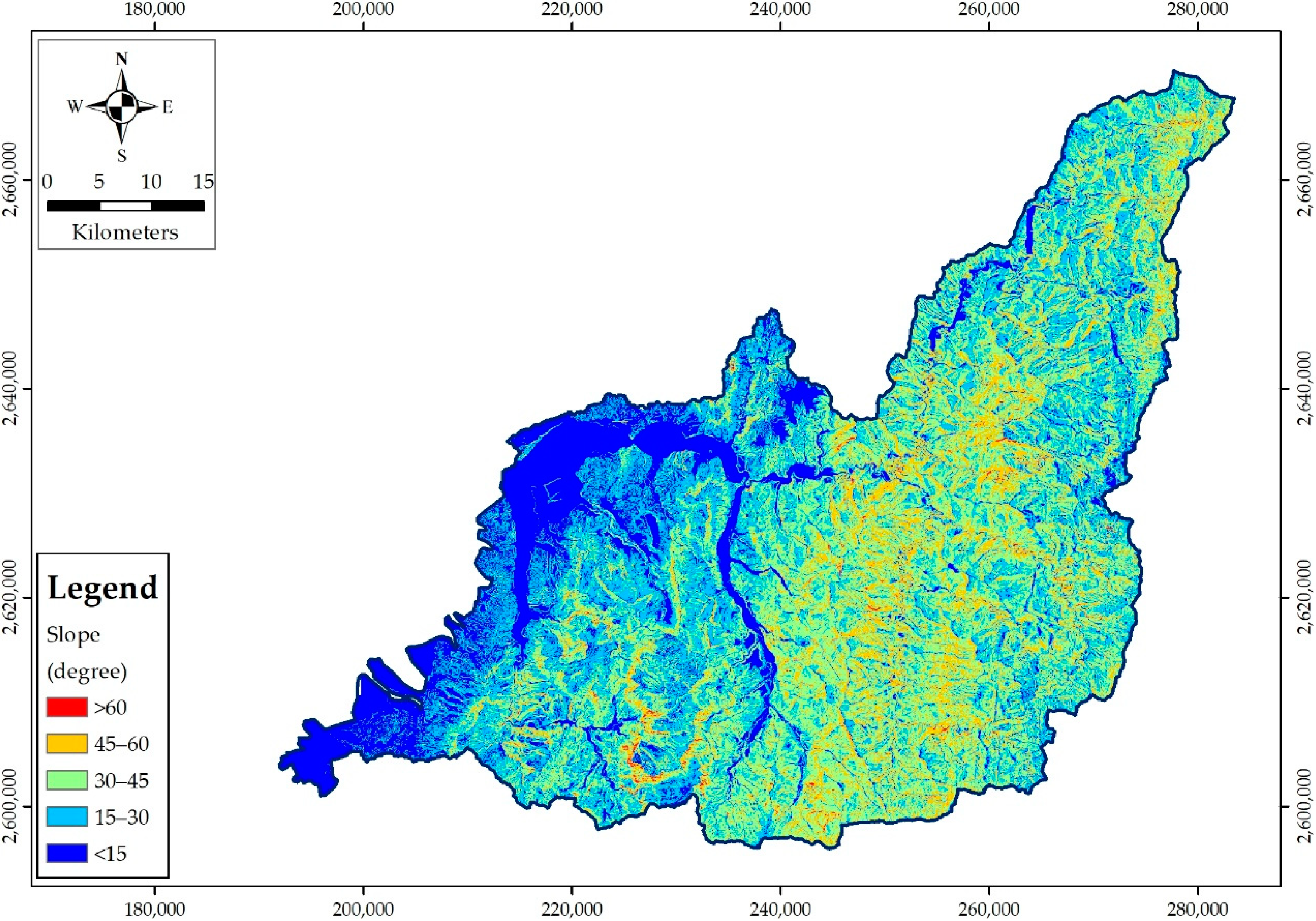
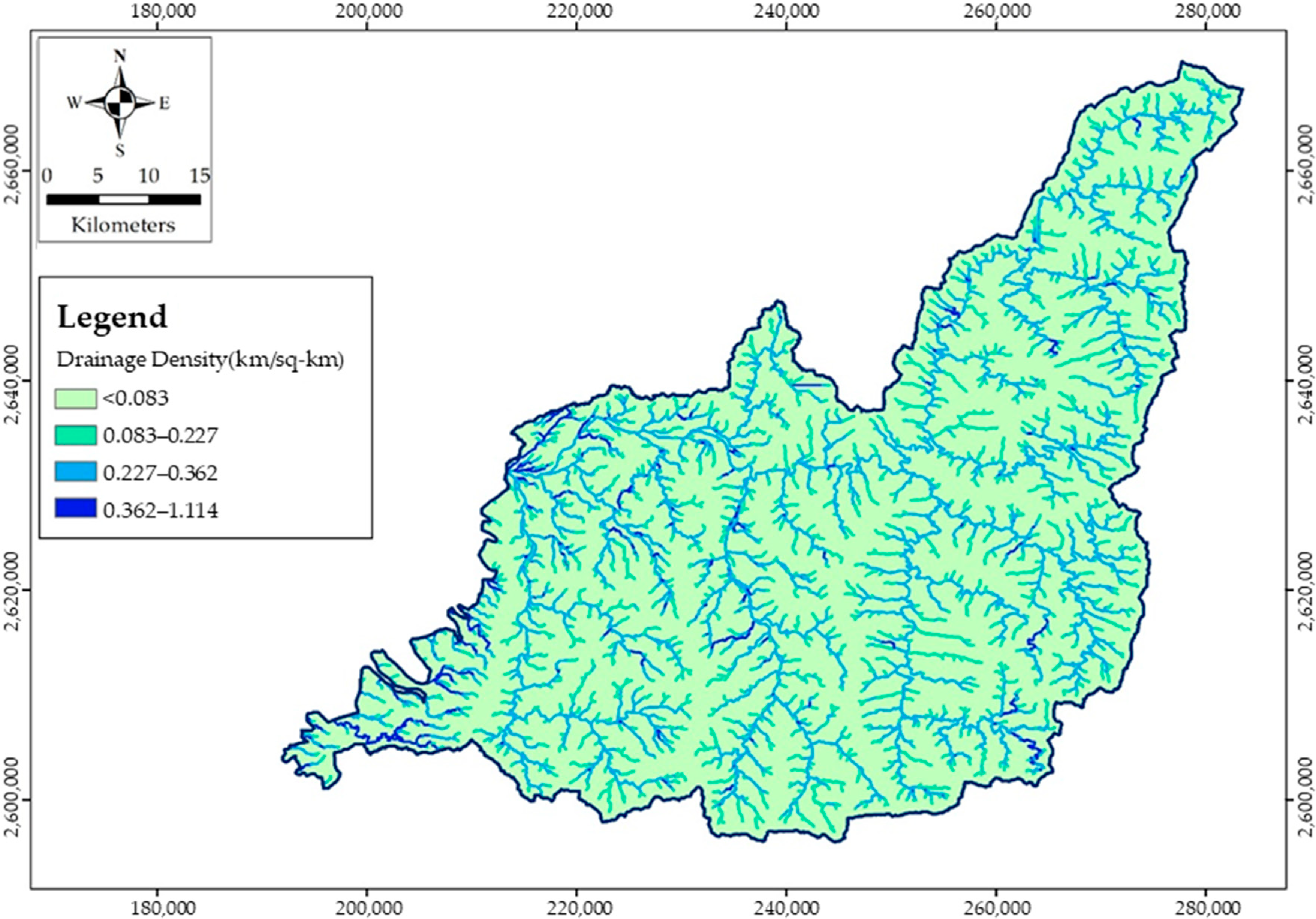

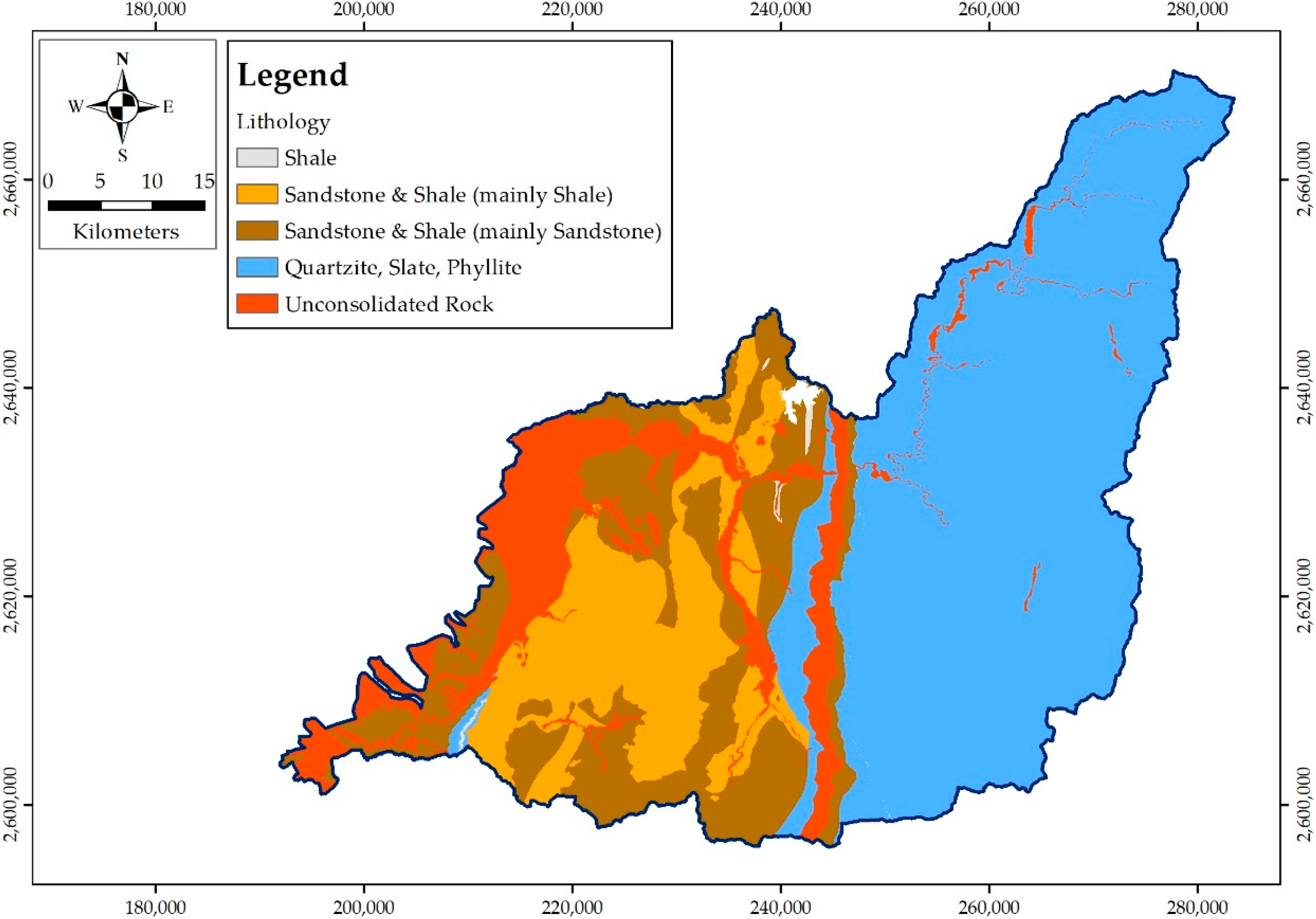
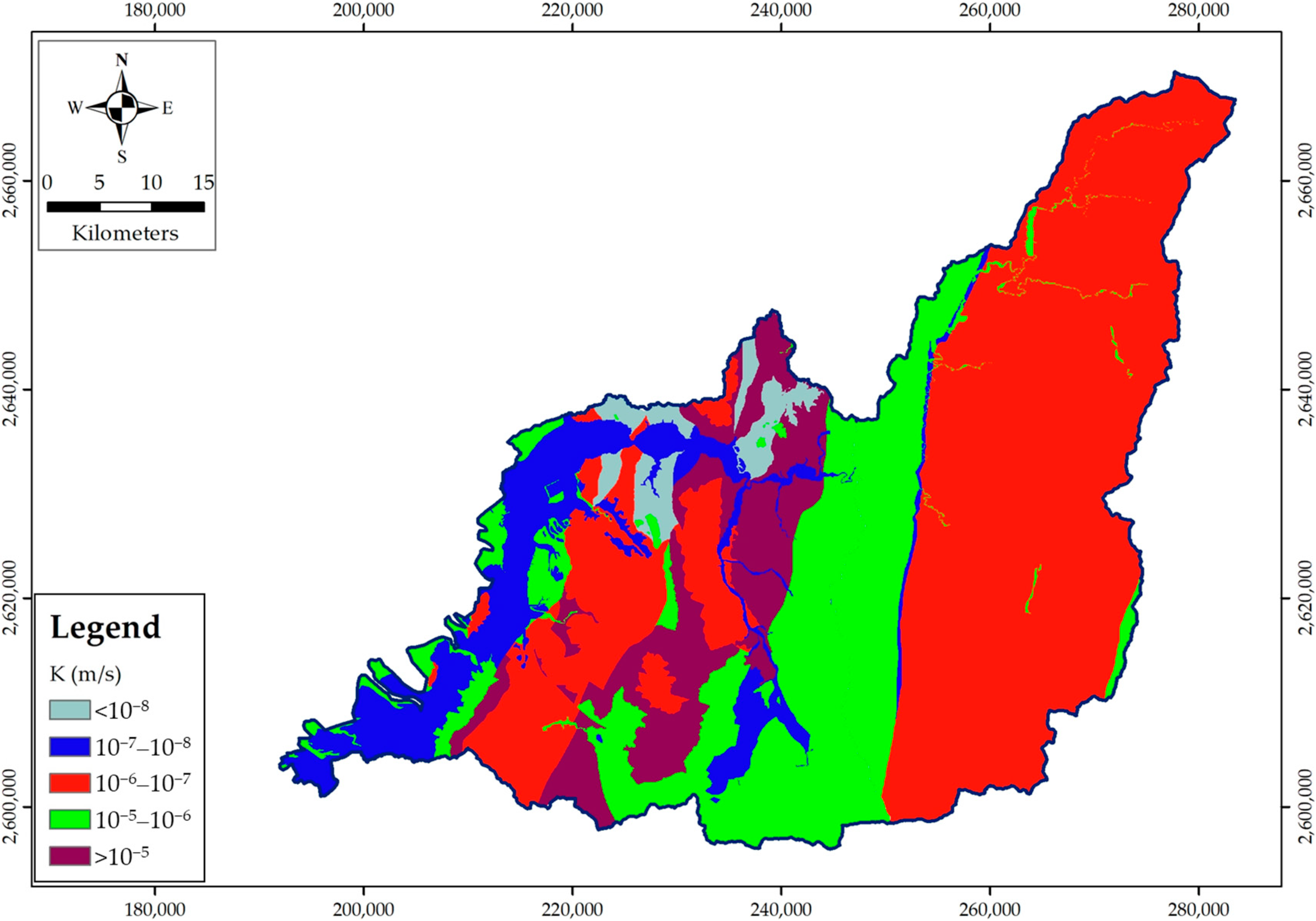
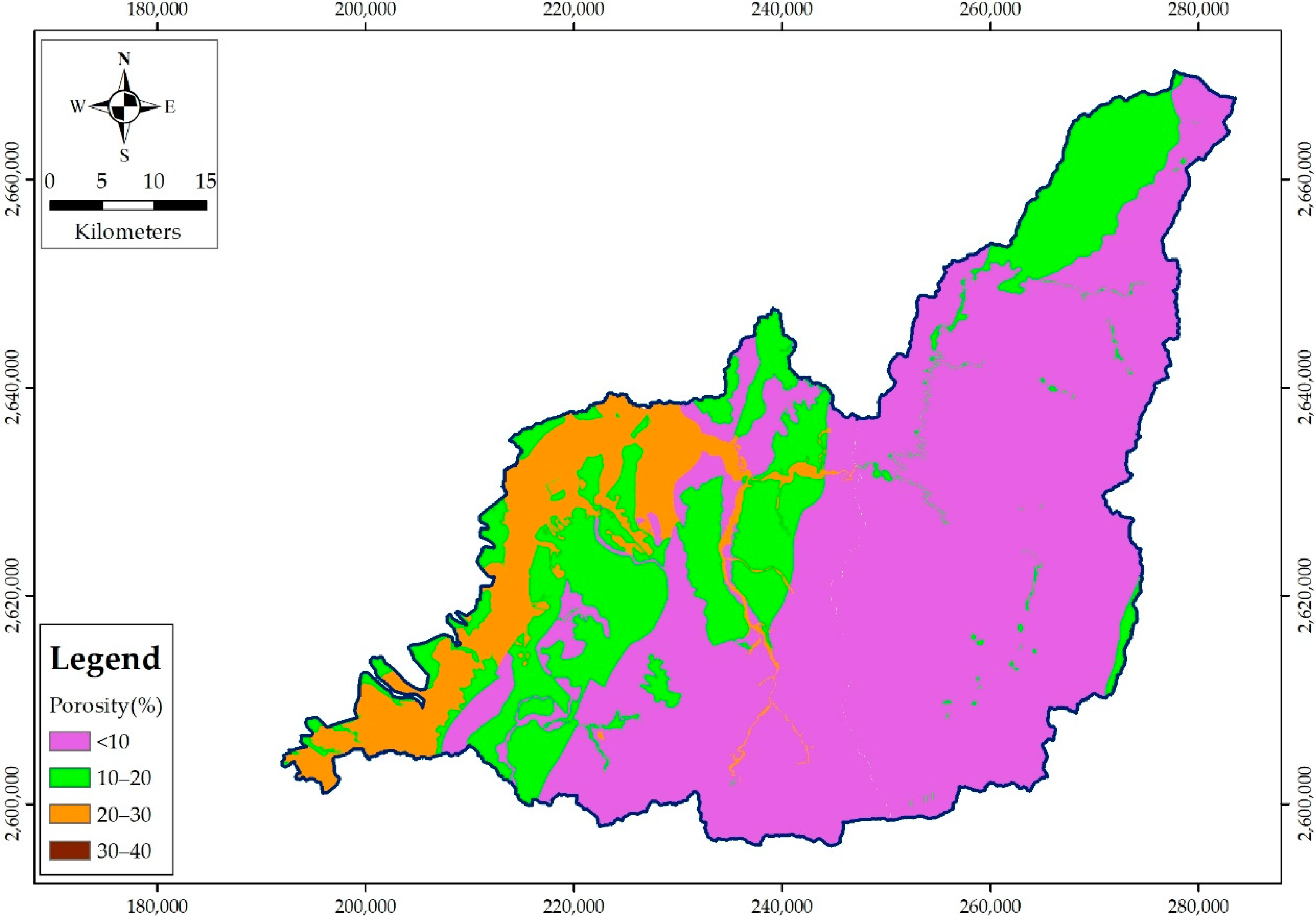
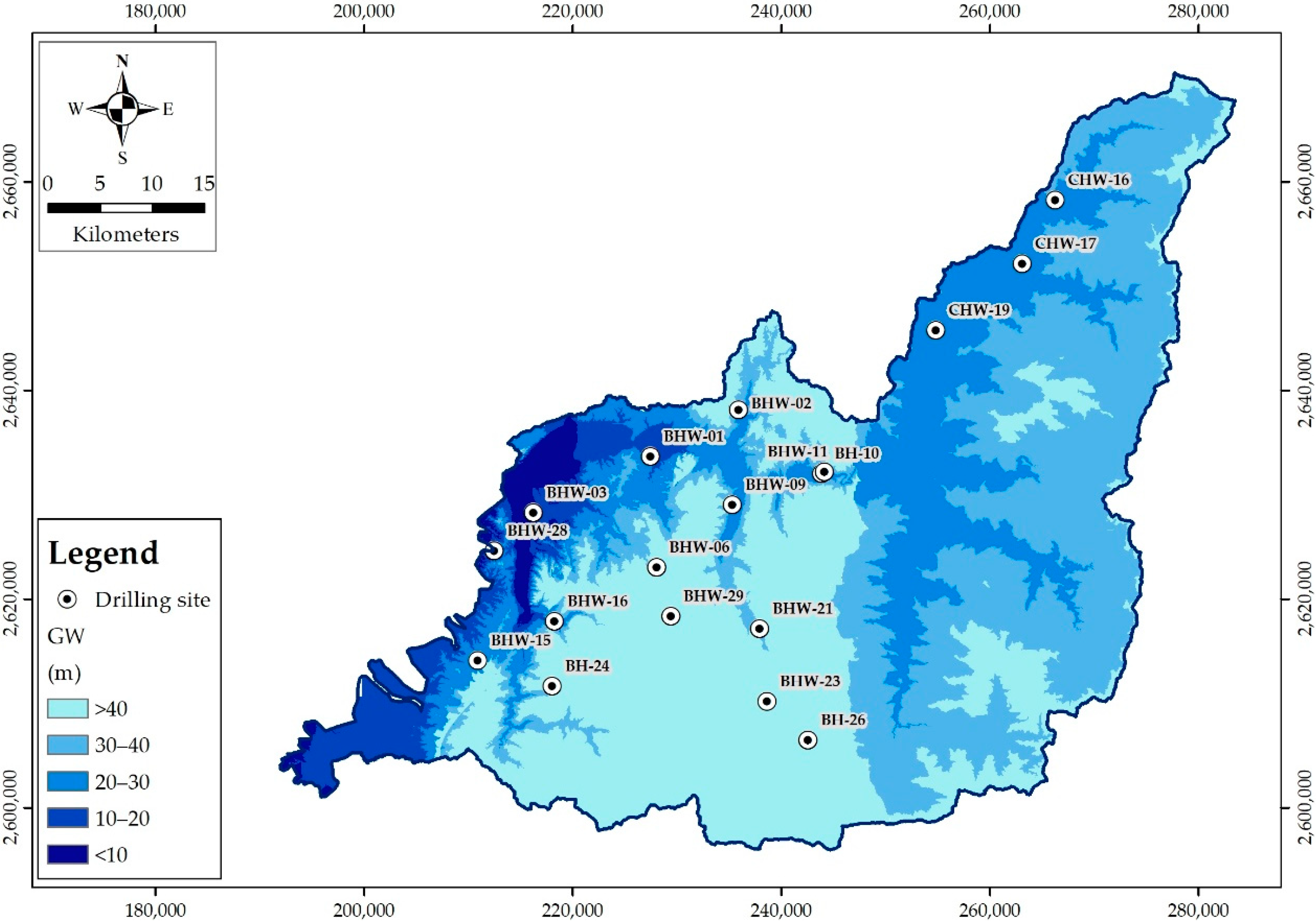

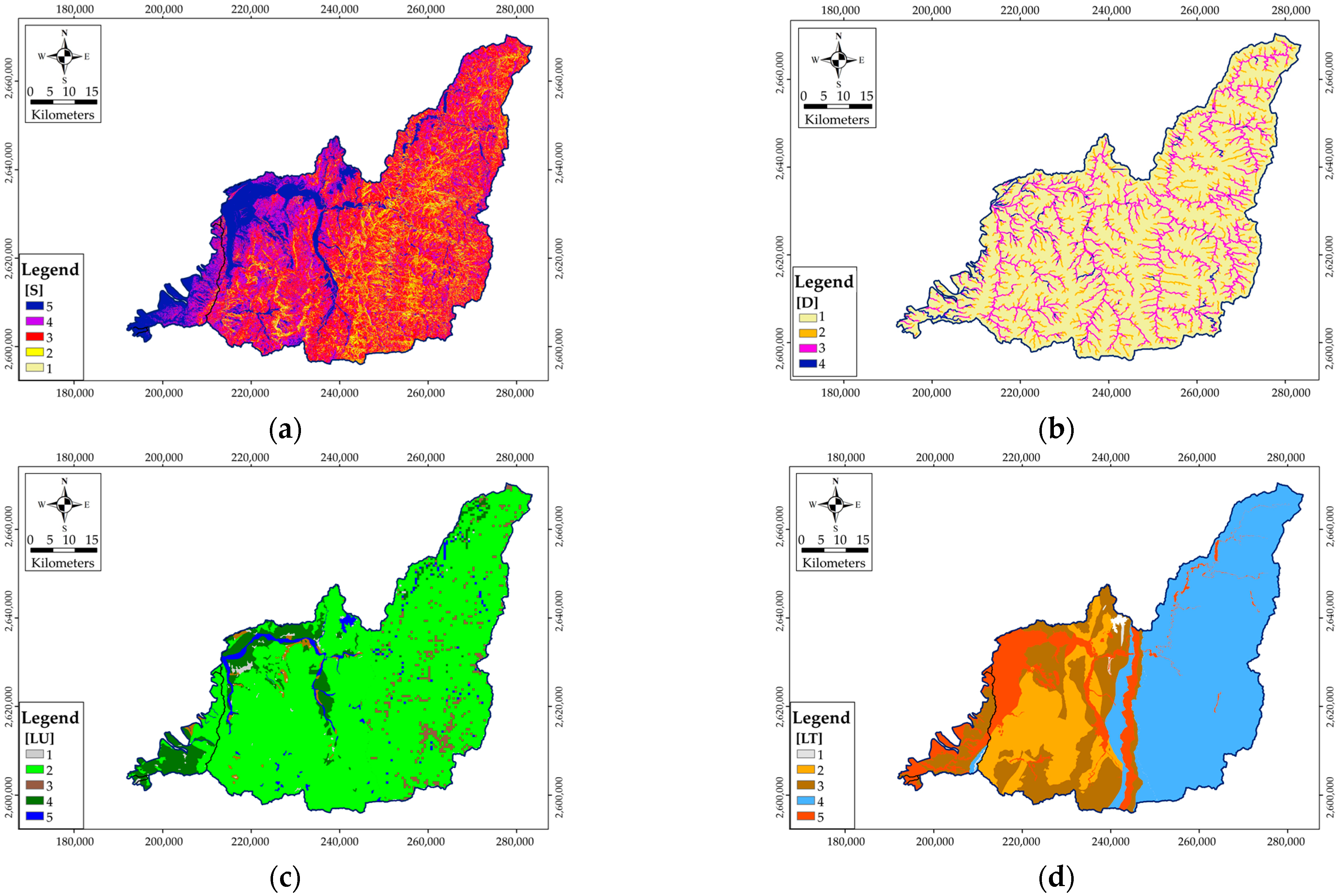
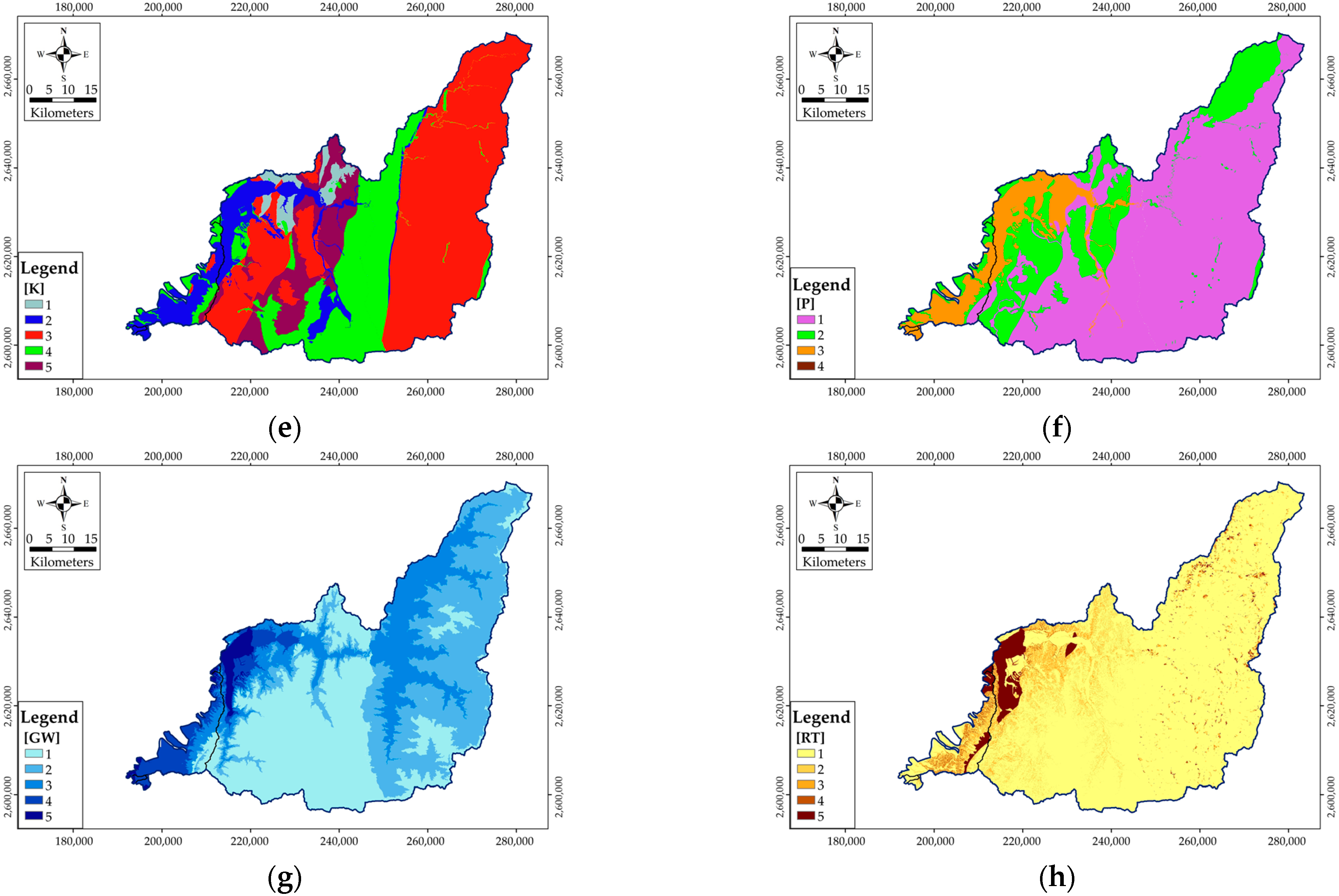
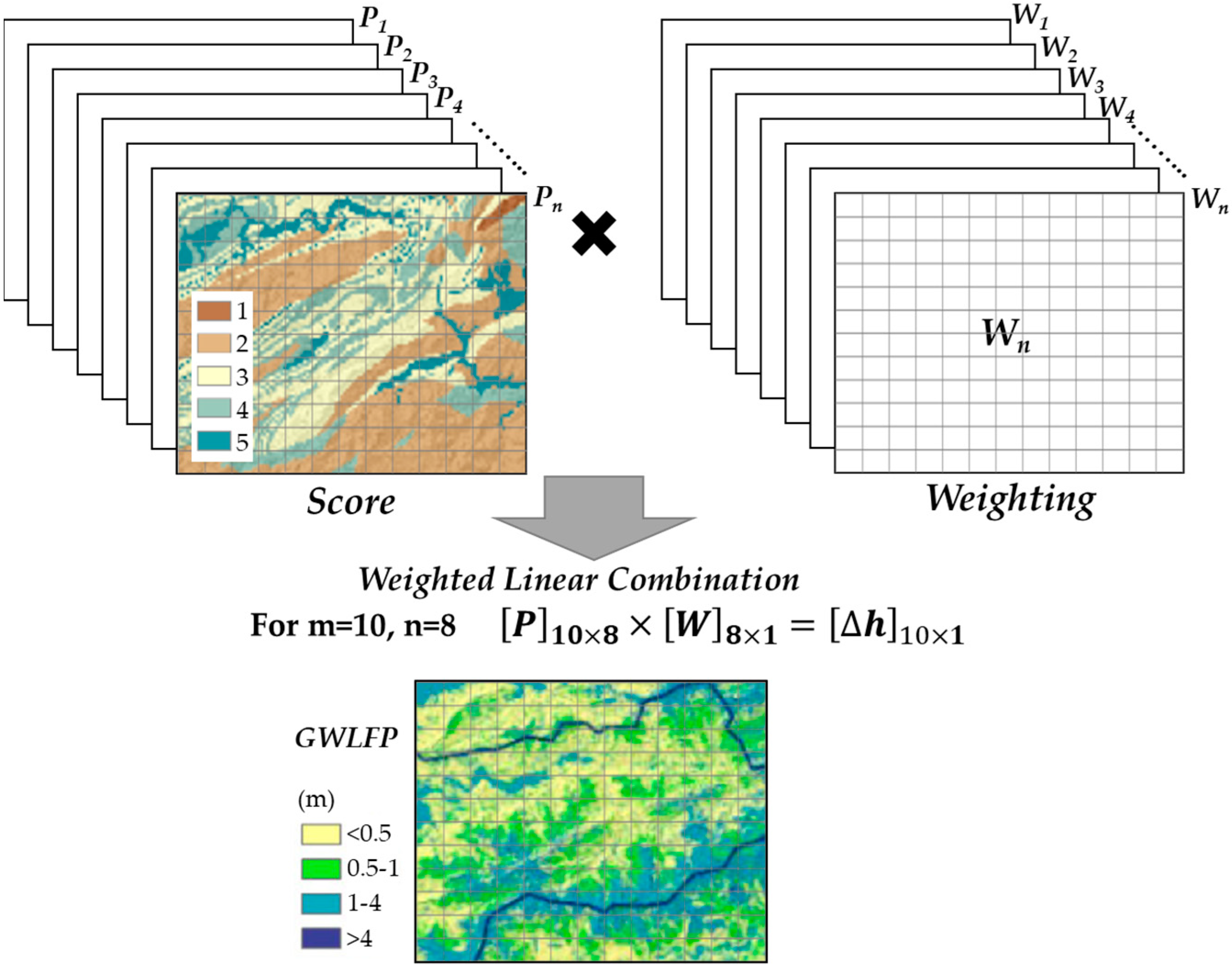


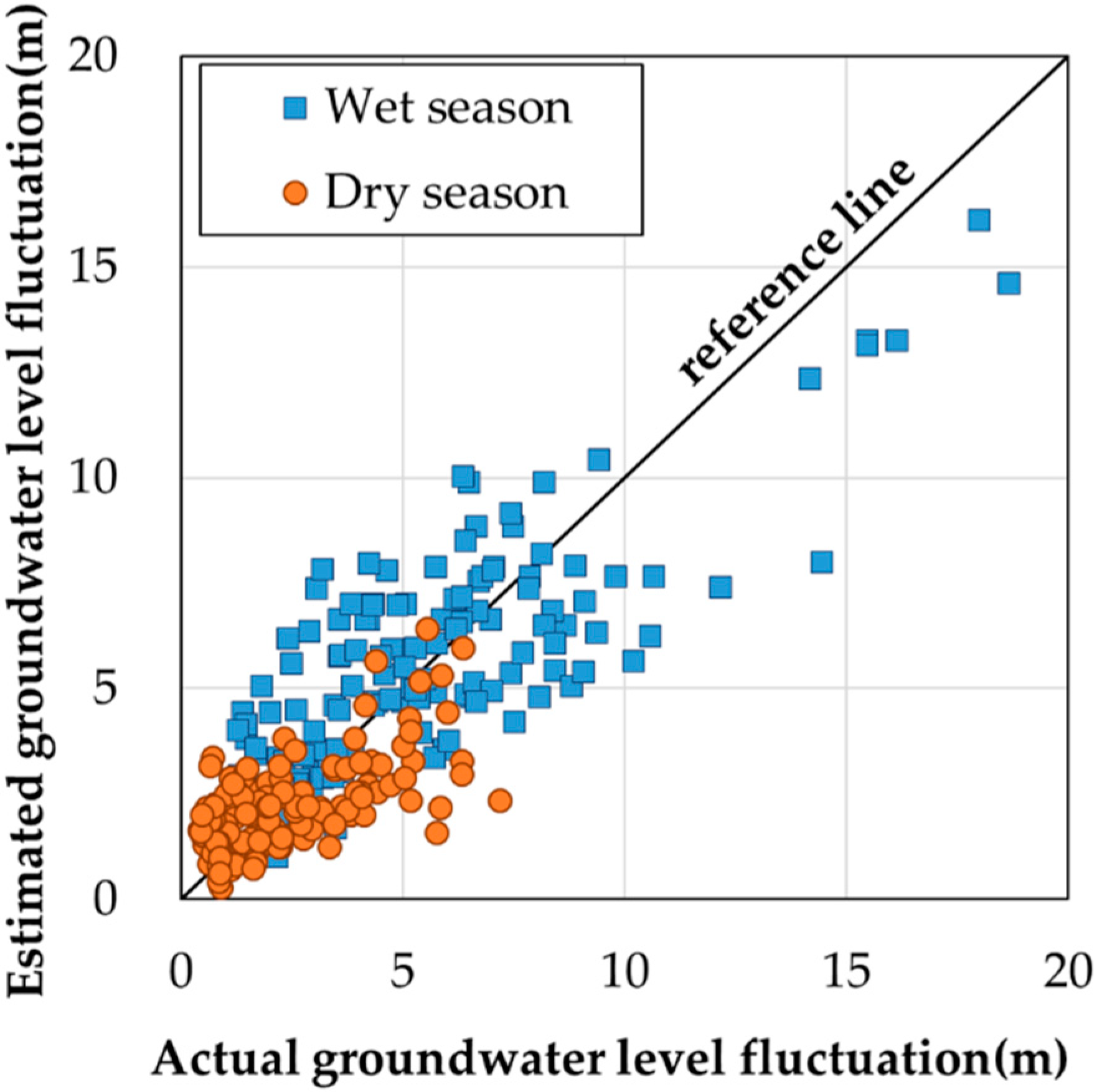
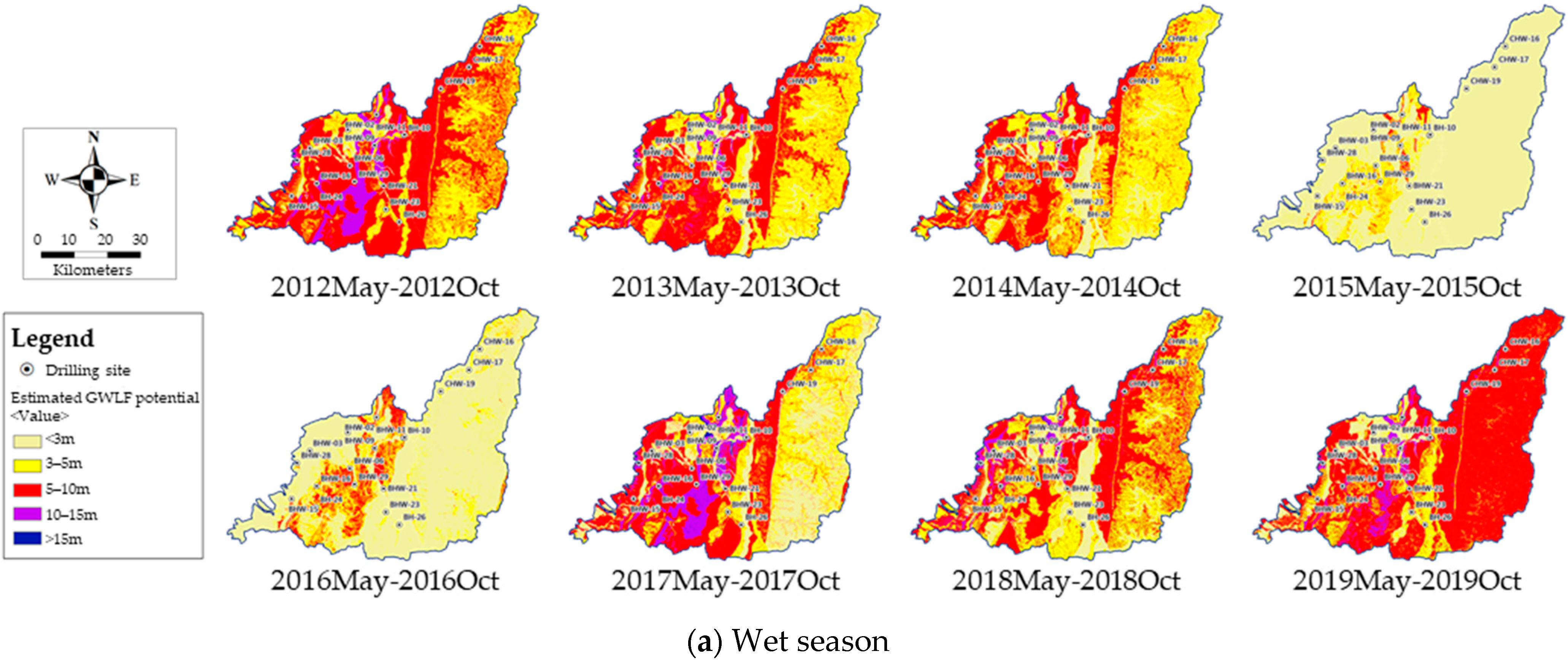
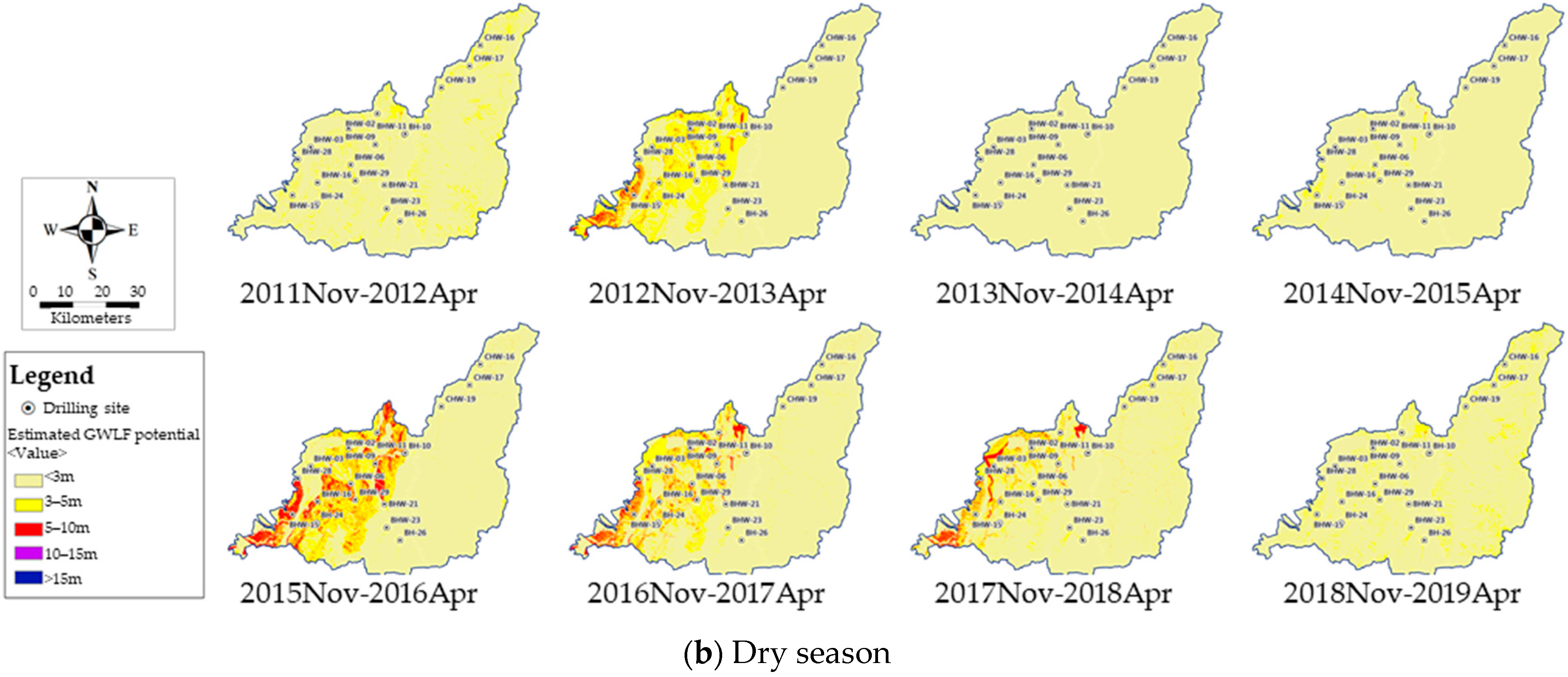
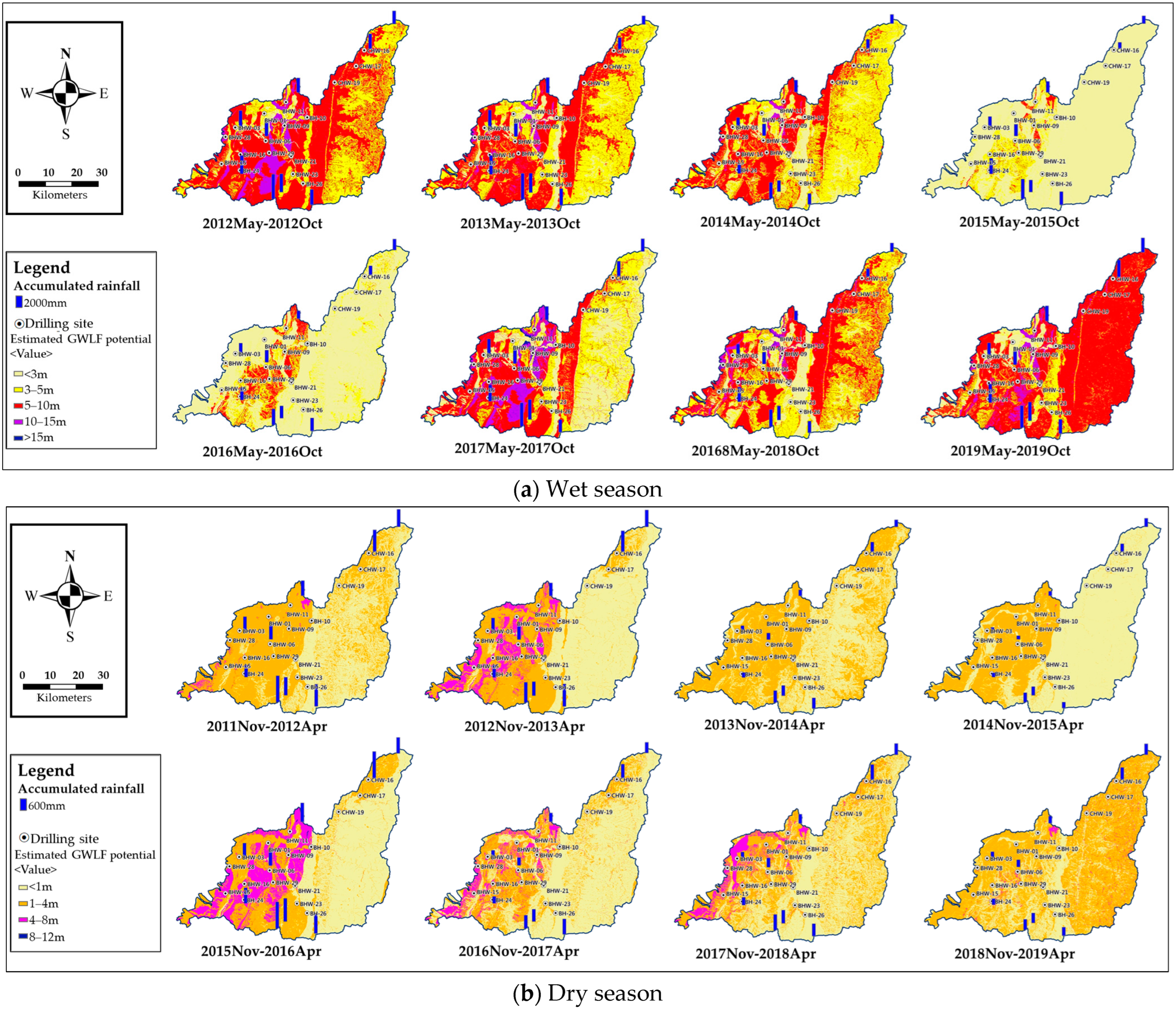

| Category | Influencing Factor | Upper Bound | Lower Bound | Feature Score | GWLF Potential |
|---|---|---|---|---|---|
| Geomorphologic Factor | Slope [S] (degree) | 90 | 60 | 1 | Low |
| 60 | 45 | 2 | |||
| 45 | 30 | 3 | ↓ | ||
| 30 | 15 | 4 | |||
| 15 | 0 | 5 | High | ||
| Drainage density [D] (km/km2) | 0.083 | 0 | 1 | Low | |
| 0.227 | 0.083 | 2 | |||
| 0.362 | 0.227 | 3 | ↓ | ||
| 1.114 | 0.362 | 4 | High | ||
| Land use [LU] | Built-up land | 1 | Low | ||
| Forest | 2 | ||||
| Exposed area | 3 | ↓ | |||
| Crop land | 4 | ||||
| Water | 5 | High | |||
| Geological Factor | Lithology [LT] | Shale | 1 | Low | |
| Sandstone & shale (mainly shale) | 2 | ||||
| Sandstone & shale (mainly sandstone) | 3 | ↓ | |||
| Slate, Phyllite, Quartzite | 4 | ||||
| Unconsolidated Rock | 5 | High | |||
| Regolith thickness [RT] (m) | < | 10 | 1 | Low | |
| 10 | 20 | 2 | |||
| 20 | 30 | 3 | ↓ | ||
| 30 | 40 | 4 | |||
| > | 40 | 5 | High | ||
| Hydrogeological Factor | Hydraulic conductivity [K] (×10−9 m/s) | 10 | 0 | 1 | Low |
| 100 | 10 | 2 | |||
| 1000 | 100 | 3 | ↓ | ||
| 10,000 | 1000 | 4 | |||
| > | 10,000 | 5 | High | ||
| Porosity [P] (%) | 10 | 0 | 1 | Low | |
| 20 | 10 | 2 | |||
| 30 | 20 | 3 | ↓ | ||
| 40 | 30 | 4 | High | ||
| Depth to the water table [GW] (m) | > | 40 | 1 | Low | |
| 30 | 40 | 2 | |||
| 20 | 30 | 3 | ↓ | ||
| 10 | 20 | 4 | |||
| < | 10 | 5 | High | ||
| November 2011–October 2012 | November 2012–October 2013 | November 2013–October 2014 | November 2014–October 2015 | November 2015–October 2016 | November 2016–October 2017 | November 2017–October 2018 | November 2018–October 2019 | |||||||||
|---|---|---|---|---|---|---|---|---|---|---|---|---|---|---|---|---|
| Well No | D | W | D | W | D | W | D | W | D | W | D | W | D | W | D | W |
| BHW-01 | 2.04 | 3.89 | 1.28 | 2.20 | 0.51 | 1.57 | 0.45 | 1.68 | 0.99 | 1.92 | 1.55 | - | 2.25 | 2.35 | 0.79 | 2.22 |
| BHW-02 | 3.47 | 4.37 | 3.45 | 4.43 | 1.25 | 4.59 | 2.17 | 4.99 | 2.56 | 3.52 | 3.42 | - | 4.13 | 3.95 | 3.71 | 3.00 |
| BHW-03 | 1.10 | 2.94 | 1.39 | 2.49 | 0.40 | 1.95 | 0.93 | 2.32 | 0.72 | 1.53 | 0.66 | 2.31 | 0.55 | 2.17 | 0.72 | 2.16 |
| BHW-06 | 5.16 | 8.66 | 7.17 | 8.18 | 1.76 | 8.44 | 1.86 | 8.81 | 6.32 | 7.44 | 3.17 | 9.09 | 4.12 | 7.00 | 3.75 | 7.70 |
| BHW-09 | 2.32 | 15.46 | 3.90 | 16.14 | 1.20 | 14.16 | 1.27 | 7.06 | 4.38 | 6.72 | 5.55 | 17.98 | 5.85 | 18.67 | 2.56 | 15.47 |
| BH-10 | 4.27 | 4.97 | 6.31 | 4.74 | 2.09 | - | 5.23 | 5.74 | 6.35 | 6.61 | 5.14 | 6.78 | 1.95 | 3.56 | 3.44 | 4.71 |
| BHW-11 | 1.72 | 4.35 | 2.73 | 3.97 | 1.36 | 3.58 | 1.25 | 3.45 | 2.58 | 3.05 | 2.29 | 7.03 | 1.39 | 1.82 | 1.39 | 4.89 |
| BHW-15 | 2.08 | 2.98 | 5.75 | 3.65 | 2.22 | 2.60 | 0.69 | 2.64 | 3.82 | 2.75 | 0.82 | 2.00 | 1.68 | 3.48 | 1.61 | 2.89 |
| BHW-16 | 1.17 | 8.37 | 0.96 | 6.67 | 0.70 | 6.40 | 0.62 | 5.36 | 1.19 | 5.19 | 1.12 | 8.44 | 1.20 | 6.66 | 0.45 | 6.19 |
| BHW-21 | 1.02 | 8.19 | 1.76 | 6.49 | 0.64 | 3.06 | 0.69 | 2.40 | 1.49 | 3.20 | 0.99 | 9.43 | 1.04 | 4.24 | 1.45 | 6.37 |
| BHW-23 | 0.93 | 6.98 | 1.35 | 4.16 | 1.03 | 3.32 | 0.88 | 2.62 | 1.54 | 2.23 | 1.28 | 7.86 | 0.85 | 2.76 | 0.85 | 5.29 |
| BH-24 | 2.20 | 4.23 | 1.93 | 3.55 | 0.90 | 3.58 | 1.14 | 5.29 | 5.37 | - | - | 5.75 | 2.22 | 2.50 | 1.16 | 2.90 |
| BH-26 | 1.03 | 2.00 | 0.77 | 1.39 | 0.89 | 1.46 | 0.87 | 1.47 | 0.57 | 1.29 | 0.63 | 2.59 | 0.74 | 1.30 | 0.45 | 1.70 |
| BHW-28 | 2.03 | 7.48 | 0.57 | 6.66 | 0.77 | 6.32 | 0.90 | 5.41 | 1.97 | 6.03 | 0.87 | 6.41 | 0.66 | 7.44 | 0.86 | 8.14 |
| BHW-29 | 2.24 | 10.65 | 1.91 | 9.79 | 2.64 | 10.57 | 2.74 | 9.36 | 2.22 | 12.17 | 1.75 | 8.88 | 1.99 | 10.20 | 4.49 | 14.46 |
| CHW-16 | 3.13 | 8.09 | 5.82 | 6.53 | 3.33 | 5.93 | 2.93 | 5.72 | 5.02 | 3.19 | 2.86 | 9.06 | 1.67 | 3.44 | 1.75 | 7.51 |
| CHW-17 | 4.19 | 6.23 | 4.70 | 5.88 | 2.02 | 5.77 | 2.69 | 5.49 | 5.00 | 5.04 | 6.00 | 7.82 | 5.16 | 6.17 | 4.03 | 6.33 |
| CHW-19 | 4.41 | 5.06 | 4.03 | 3.83 | 0.99 | 4.51 | 1.19 | 4.35 | 3.62 | 3.51 | 3.92 | 4.64 | 0.85 | 3.85 | 4.07 | 4.31 |
Publisher’s Note: MDPI stays neutral with regard to jurisdictional claims in published maps and institutional affiliations. |
© 2022 by the authors. Licensee MDPI, Basel, Switzerland. This article is an open access article distributed under the terms and conditions of the Creative Commons Attribution (CC BY) license (https://creativecommons.org/licenses/by/4.0/).
Share and Cite
Chen, N.-C.; Wen, H.-Y.; Li, F.-M.; Hsu, S.-M.; Ke, C.-C.; Lin, Y.-T.; Huang, C.-C. Investigation and Estimation of Groundwater Level Fluctuation Potential: A Case Study in the Pei-Kang River Basin and Chou-Shui River Basin of the Taiwan Mountainous Region. Appl. Sci. 2022, 12, 7060. https://doi.org/10.3390/app12147060
Chen N-C, Wen H-Y, Li F-M, Hsu S-M, Ke C-C, Lin Y-T, Huang C-C. Investigation and Estimation of Groundwater Level Fluctuation Potential: A Case Study in the Pei-Kang River Basin and Chou-Shui River Basin of the Taiwan Mountainous Region. Applied Sciences. 2022; 12(14):7060. https://doi.org/10.3390/app12147060
Chicago/Turabian StyleChen, Nai-Chin, Hui-Yu Wen, Feng-Mei Li, Shih-Meng Hsu, Chien-Chung Ke, Yen-Tsu Lin, and Chi-Chao Huang. 2022. "Investigation and Estimation of Groundwater Level Fluctuation Potential: A Case Study in the Pei-Kang River Basin and Chou-Shui River Basin of the Taiwan Mountainous Region" Applied Sciences 12, no. 14: 7060. https://doi.org/10.3390/app12147060
APA StyleChen, N.-C., Wen, H.-Y., Li, F.-M., Hsu, S.-M., Ke, C.-C., Lin, Y.-T., & Huang, C.-C. (2022). Investigation and Estimation of Groundwater Level Fluctuation Potential: A Case Study in the Pei-Kang River Basin and Chou-Shui River Basin of the Taiwan Mountainous Region. Applied Sciences, 12(14), 7060. https://doi.org/10.3390/app12147060







